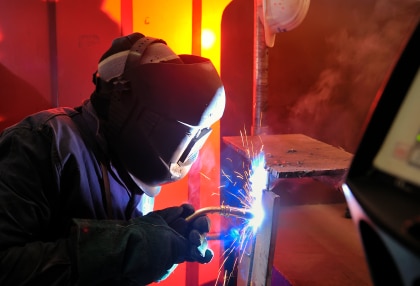What is MIG Welding

MIG welding, also known as Gas Metal Arc Welding (GMAW), is a process that utilizes a continuously fed solid electrode, shielding gas from an externally supplied source, and electrical power to melt the electrode and deposit this molten material in the weld joint. The equipment used automatically regulates the electrical characteristics of the arc. The only manual controls required of the welder for semi-automatic operation are travel speed, travel direction and gun (torch) positioning. Given proper equipment settings, the power supply will provide the necessary amperage to melt the electrode at the rate required to maintain the pre-selected arc length (voltage). For example, an increased stick-out, produced by drawing the torch back from the work piece, results in a reduction in current from the power supply. This maintains the same heating of the electrode and returns the arc length to its preset condition. Filler metal selection should be closely matched to the base material being welded. In MIG Welding, the filler metal not only conducts current to the arc zone (resulting in melting the base metal and electrode), but adds reinforcement to the completed weld joint.
MIG Welding can be used on a wide variety of metals and in a number of different base metal thicknesses. Its successful application depends on proper selection of:
- Electrode – composition, diameter and packaging
- Shielding Gas – type (composition), purity and flow rate
- Process Variables – current, voltage, mode of metal transfer and travel speed
- Equipment – power source, welding gun and wire feeder
Why Use MIG Welding?
- It is a high-productivity, low cost welding process
- It can be used to weld all types of commercially available metals and alloys
- Welding can be done in all positions with proper selection of equipment and parameters
- Using a continuously-fed electrode maintains a high operator duty cycle and minimizes the occurrence of defects on starts and stops
- Deep weld penetration can be obtained which permits the use of small weld sizes for equivalent weld strengths in certain applications
- Minimal post-weld clean-up is required due to the absence of a covering slag on the weld bead
- Welding speeds and weld metal deposition rates are higher than those obtained with Stick Welding
- Ideal for multi-pass welding (with proper filler metal selection)
- Less operator skill is required compared to Stick Welding
- Fume rates are at very low levels compared to Stick Welding and Flux Cored Welding
- A wide selection of filler metal compositions and diameters are available to weld thick or thin material
- This process is ideal for mechanized welding
- This process offers improved electrode deposition efficiency compared to Stick Welding and FCAW
- X-ray quality welds can be produced
Limitations
- Welding equipment is more complex, more costly and less portable than that for Stick Welding
- The required welding torch makes reaching into constricted areas difficult, and the need for good gas shielding necessitates the torch being relatively close to the weld area
- The welding arc with its gas shield must be protected from drafts that might cause the shielding to be blown away from the arc. This limits the use of the process outdoors unless protective shields are placed around the work area
- Relatively high levels of radiated heat and light may cause operator discomfort and initial resistance to the process
- Burn through is a common issue when welding extremely thin materials (<1/16”)
- With conventional transfer when welding out of position, weld metal deposition rates are less than those achieved with Flux Cored Welding
- This process does not perform well where base metal contamination is a problem. The base metal must be clean and rust free
- Lack of fusion defects may result where process parameters are incorrectly set. This is especially critical when welding base metals thicker than 1/4”
Source:Praxair